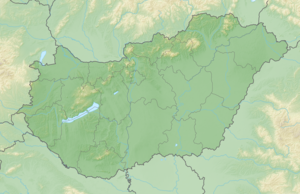Eger Castle (Hungary)
| Eger Castle | ||
|---|---|---|
|
View of the castle from the west |
||
| Creation time : | early 13th century | |
| Castle type : | Hilltop castle | |
| Conservation status: | Inner castle and bastions preserved | |
| Place: | Eger , Hungary | |
| Geographical location | 47 ° 54 '14 " N , 20 ° 22' 45.8" E | |
| Height: | 180 m | |
|
|
||
The Castle Eger ( Hungarian Egri vár ) is a castle in the Hungarian town of Eger , which lies immediately to the west of the city center on a hill. The hilltop castle was built from the early 13th century and is historically best known for the successful defense against the Ottoman siege in 1552 , which was processed literarily in the novel Stars of Eger by Géza Gárdonyi .
history
middle Ages
From the early 11th century, the seat of the diocese of Eger , founded by Stephan I , the first king of Hungary, was located on today's castle hill . The oldest archaeological remains in today's castle also date from this period. The first three-aisled cathedral was built at the end of the 11th century. After the Mongol storm , during which Eger was also looted and set on fire, fortified castles were built throughout Hungary under King Béla IV . The construction of the fortifications began in Eger in 1248. In the 15th century the castle was completely expanded. The Gothic bishop's palace, built from 1468 to 1472 , made it a representative bishopric.
Siege 1552
In the period of "trichotomy" of Hungary during the first Austrian Turkish war the castle Eger belonged to the Royal Hungary under Ferdinand I . In 1549 István Dobó became captain of the castle and prepared the castle with supplies and the construction of an additional bastion for a possible attack by the Ottoman army. In 1552 the armies of Kara Ahmed Paschas and Ali Pascha Hadıms began a campaign in which they captured numerous castles (including Temesvár ) and united at Szolnok to form an army of around 70,000 men. Then they moved towards Eger.
The Ottoman troops besieged the Eger Castle, which was occupied by only about 2,000 soldiers and civilians under the command of Dobó, for five weeks in September and October 1552. Although the Ottomans were outnumbered and soon destroyed the outer walls of the castle, they did not succeed in taking Eger Castle. From October 11th to 13th, they launched an assault attack, which was repulsed, among other things, with the help of the "Women of Eger", who poured bad luck and hot water over the attackers . In view of the approaching winter, the Ottomans then withdrew from Eger.
After the siege, however, the castle was almost completely destroyed, which in addition to shelling and explosions by the Ottomans, the explosion of the gunpowder tower during the fighting had contributed. The “Defenders of the Hero City” turned to Palatine Thomas Nádasdy with a request for the castle to be rebuilt . After the hoped-for support initially failed to materialize, Dobó resigned from his position as captain of the castle.
Decline and reconstruction
From around 1560, the fortifications were gradually rebuilt, including bastions and casemates built in Italian style. In 1596 the castle was besieged again by the Ottomans and captured after a few days. After 91 years of Ottoman rule over Eger, the Austro-Hungarian troops recaptured the town and the castle in 1687. Allegedly out of fear that the Hungarians could use the castle for an uprising against the Habsburg monarchy , large parts of the fortifications - including the entire outer castle - were demolished from 1702 on by imperial orders. In fact, during the struggle for freedom of Francis II Rákóczi in 1710 , the castle briefly fell into the hands of the rebels.
In the period that followed, the stones from the castle were also used as building material for the new baroque buildings in Eger. The castle continued to decline until the 19th century, when the first excavations were carried out on the site of the earlier cathedral. Large parts of the castle were restored or rebuilt in the 19th and 20th centuries.
Parts of the eastern bastion were destroyed in 1906/07 when the railway line to Putnok was built , which has since passed through the castle complex. In 1974 the Dobó bastion partially collapsed, but was rebuilt in the 1990s.
Web links
- Eger Castle website (Hungarian, English, Polish)
- Eger Castle / Fortress. In: Burgenwelt.org
Individual evidence
- ↑ László Kontler: A History of Hungary: Millennium in Central Europe . Palgrave Macmillan, Basingstoke 2002, ISBN 978-1-4039-0317-4 , pp. 147 .
- ^ The Story of Eger Castle (Part 2) - The Siege of 1552. In: ieger.com , accessed on May 28, 2020.
- ↑ György Dalos: Hungary in a nutshell: A millennium and twenty years . 2nd Edition. CH Beck, Munich 2012, ISBN 978-3-406-63544-1 , p. 69 ( limited preview in Google Book search).
- ↑ The Story of Eger Castle (Part 3) - Decay. In: ieger.com , accessed on May 28, 2020.
- ↑ Blackboard by the castle, photo on egrinapok.hu (accessed on May 28, 2020).

